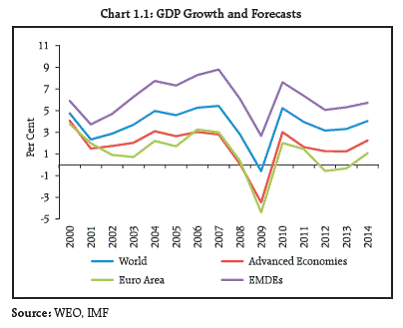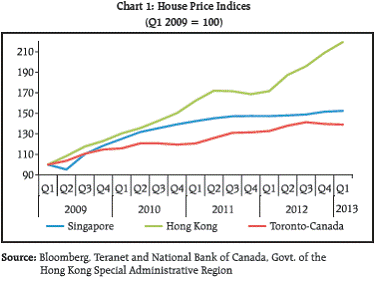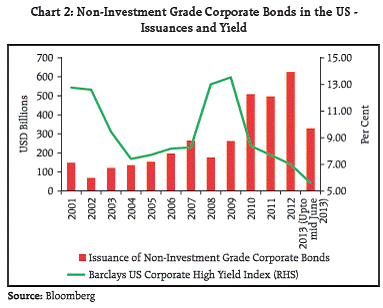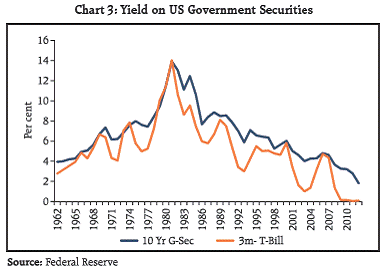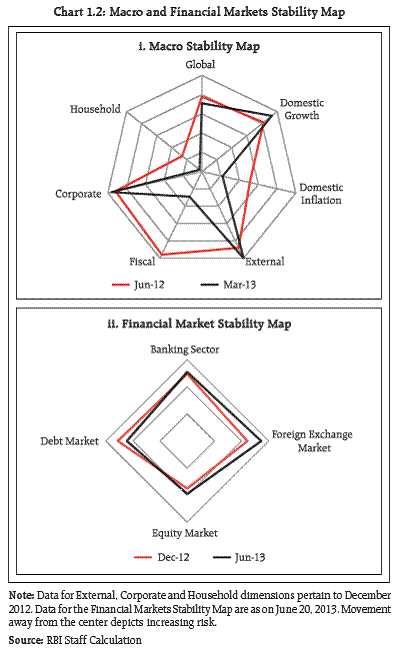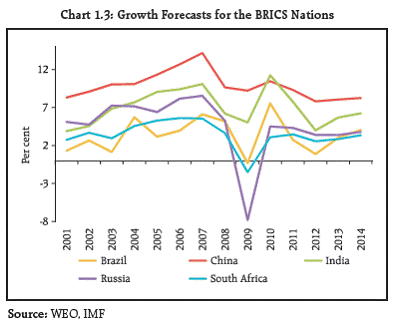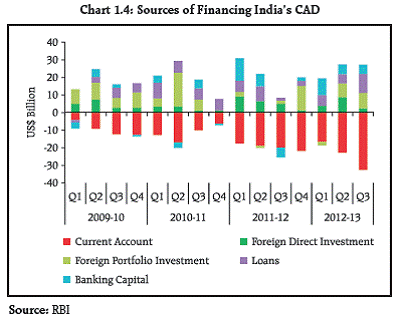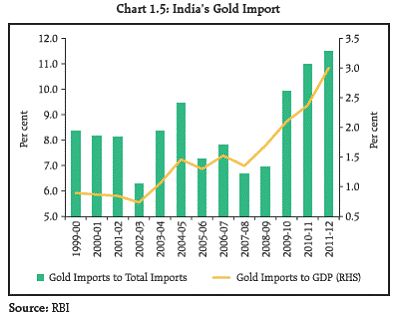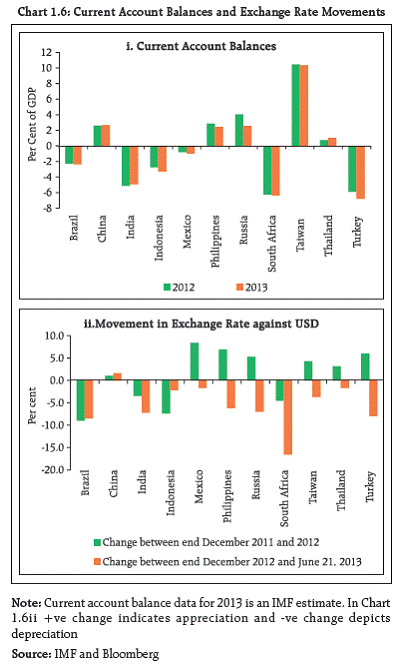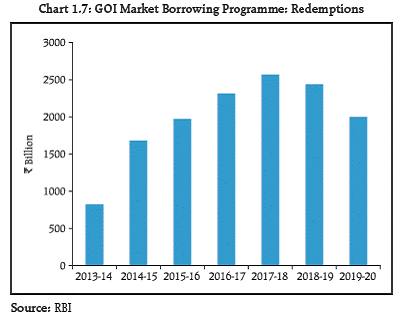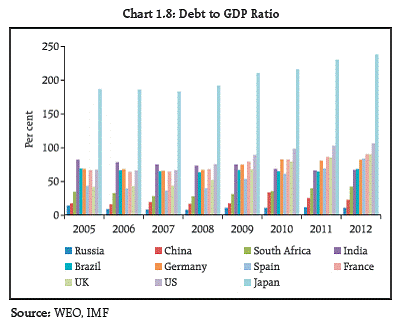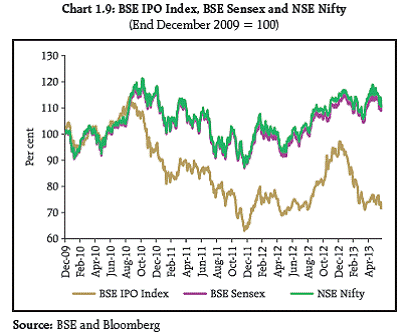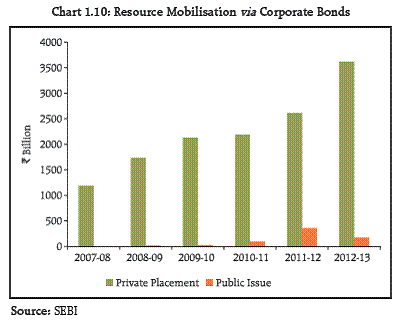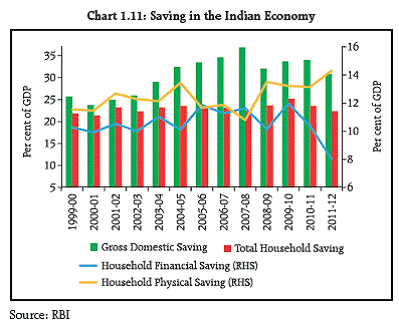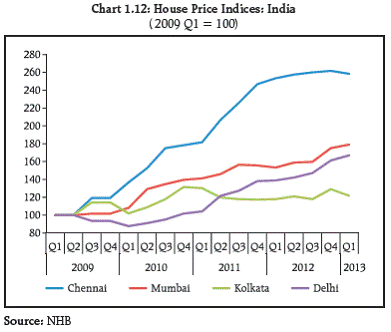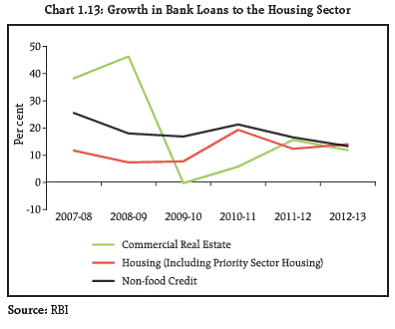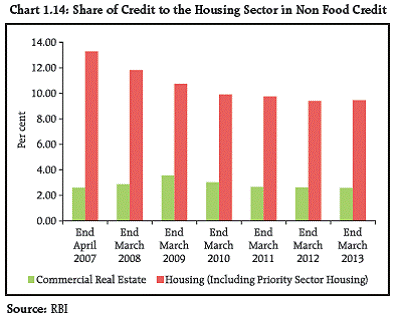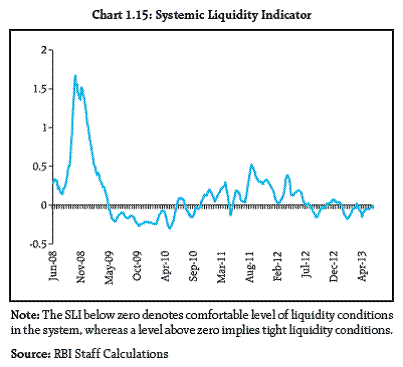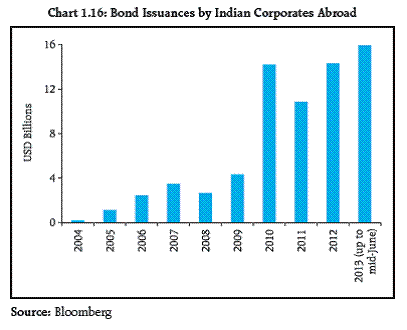 IST,
IST,
Chapter I : Macro-Financial Risks
The gradual improvement in financial conditions that was setting in with the receding of tail risks in the global economy due to policy actions, has been interrupted by the recent turbulence in financial markets. Risk-off flights to safety triggered by apprehensions of global liquidity contracting with the Federal Reserve (Fed) indicating a phased withdrawal from its bond buying programme commencing later in 2013, has fuelled large scale sell off of financial assets in emerging markets leading to sharp downward movements in their equity, bond and currency markets. These developments have accentuated the spillover risks from unconventional monetary policies (UMPs) of advanced economy (AE) central banks posing new challenges to emerging economies. On the domestic front, growth remains below trend and vulnerabilities on the external front have risen. The high current account deficit (CAD) and its financing remain stress points for the Indian economy as evident from the recent depreciation of the rupee on global cues. On the other hand, there are indications that inflation is moderating, the growth slowdown appears to be at a trough and measures taken to dampen import demand for gold are taking hold. Credible progress has been made on the fiscal front, which has been reflected in the upgrading of the outlook by credit rating agencies. Going forward, improvement in the quality of fiscal consolidation will be crucial for ensuring macroeconomic stability and sustainable higher growth. Foreign institutional investors (FIIs) were net purchasers in the equity and debt markets until recently and have turned net sellers in June 2013. Resources raised from the equity market have remained low and activity in the private placement market for debt has witnessed an increase. Domestic saving as a percentage of GDP, although high, has fallen and this could further curtail the availability of investible resources. Corporates remain stressed as reflected from the lower growth in sales and profits. Given the weakness of the rupee in recent times, unhedgedexposures may further increase the vulnerabilities of the corporate sector. Global Growth 1.1 Policy actions in stressed advanced economies have reduced tail risks globally, although fiscal drag in the US, austerity fatigue and incomplete financial repair in the Euro Area, low credibility of the proposed structural reforms in Japan and subdued growth in major emerging economies continue to pose downside risks to a return to resilient and sustained recovery. Global growth remains sluggish, multi-paced and subdued (Chart 1.1). In view of the lack of fiscal space and slow traction associated with structural reforms, monetary policies remain the first line of defense in the onerous job of stabilising economies. 1.2 In the US, firm indications of the recovery taking hold are evident in the Fed’s policy announcement made on June 19, 2013 of gradual withdrawal from asset purchases commencing by the end of 2013. Growth in the US improved during Q1 2013 and the Fed expects growth to be between 2.3 per cent and 2.6 per cent in 2013. Though unemployment has fallen to around 7.6 per cent, it remains above the Fed’s comfort level. Growth, on the whole, in the US is expected to remain vulnerable to the adverse impact of the budget sequestration which could gradually gain pace in the months ahead. Future growth prospects in the US and global financial stability hinge around a credible resolution of the US debt ceiling debate.1 1.3 GDP growth in the Euro Area continues to remain in contraction mode. Among the larger Euro Area economies Germany, France, Spain, Italy and Netherlands witnessed negative y-o-y growth in GDP during Q1 2013. Credit growth to the private sector is still shrinking. Banks are reportedly repaying funds borrowed under the Long Term Refinancing Operations (LTRO). Unemployment has been increasing and it is currently high at 12.2 per cent. Youth unemployment at almost 24 per cent is a significant risk to socioeconomic stability. 1.4 Growth in the UK has been low but positive for the last three quarters and is expected to be moderate in the near term. Higher consumer spending spurred by positive wealth effects brought about by unprecedented policy action has boosted Japan’s growth to an annualised 3.5 per cent during Q1 2013, though structural issues remain a concern. Economic growth in China has been lower than anticipated during Q1 2013 raising apprehensions that economic activity could slow down further. In addition, financial stability concerns have emerged over the rapid increase in domestic credit in China. The other BRICS countries are also experiencing low growth. Unconventional Monetary Policies - Exit 1.5 UMPs in advanced economies were undertaken to restore normal functioning of financial market and to reduce the domino effects emanating from the global financial crisis. What started as a response of monetary policy to address the liquidity induced solvency issues in the financial system had been persisted with to counter recession and boost economic growth. This reduced immediate tail risks, though continuance of such monetary policy over a prolonged period may have led build up of risks (Box 1.1). 1.6 The market reaction to the recent Fed announcement could be indicative of the risks to the markets in the medium term as different central banks eventually wind up accommodative monetary policies. The inevitability of exit has shaken up markets which were lulled into comfort by the ample liquidity available in the system. Such bouts of volatility may recur frequently as tightening gets phased out over the next few years. The fragile confidence of the markets is also evidenced by the strength of the market reaction. The emerging economies have been highly affected as capital flows have reversed impacting their currencies as also equity and bond markets. In general, risks from UMP exit stem from, among other things, timing, sequencing, and speed of exit. An added challenge is managing expectations in the face of differential economic conditions between and within geographies. 1.7 Bond yields in advanced economies and Euro Area periphery have increased sharply after the Fed’s June 19, 2013 announcement. The persistence of this trend could jeopardise the progress made by stressed Euro Area countries and credit growth to the private sector could also fall further as liquidity recedes. 1.8 Risks from UMP exit are elevated even in the US as increasing yields could increase the cost of funds and threaten recovery. Even though communication from the Fed stated clearly that withdrawal from bond purchases was not pre-determined and would depend upon incoming data and evolving outlook, the markets appear to have interpreted it to mean an imminent withdrawal of bond purchases. The gap between what was stated by policy makers and how that is interpreted by markets may lead to heightened volatility in the global financial markets. Box 1.1: Unconventional Monetary Policies - Risks Asset Price Bubbles : Low interest rates may have pushed investors into riskier activities in search of yield building up asset prices and encouraged corporates to build excess leverage. House prices in some countries have already witnessed sharp increases in the last few years and the fears of a housing bubble have re-emerged. Rapid asset price inflation, particularly in the housing market, can lead to problems for financial stability as witnessed during the sub-prime crisis in the US. While house prices have fallen in the US after the crisis and are currently below the pre-crisis levels, they have increased elsewhere (Chart 1) due to, among other reasons, search for yield and increase in credit. Singapore, Canada and Hong Kong have taken measures to reduce inflation in house prices. Measures include reduction in the loan to value ratio, capping gross debt service ratio, reducing loan to value for mortgage refinancing, reducing the amortisation period, tightening of mortgage underwriting rules, removal of interest absorption schemes and transaction taxes for multiple houses. Adverse Selection: The issuances of non-investment grade corporate bonds in the US have seen a significant increase in the recent past (Chart 2). Low interest rates could have influenced non price factors such as credit standard and quality of credit appraisal. The demand for noninvestment grade corporate bonds is evident from their downward trending yields (Chart 2). Reduced Incentive to Repair Balance-sheets: Extended period of low interest rates could reduce the incentive for corporates and sovereigns to undertake the necessary balance-sheet repairs. Macroeconomic policy, at the current juncture, is faced with the challenge of ensuring short term survival without compromising on long term sustainability. Market Distortions and Mispricing of Risk: Sovereign bond yields have been kept artificially low and since sovereign bonds act as pricing benchmark for many financial products there could be under-pricing of risks in those markets. The ability of markets to price risks can fall and markets may find it difficult to function when unconventional policies are eventually withdrawn. Building up of Risks: Low interest rates in the period just after the dot com bubble bust are believed to have led to excesses in financial markets which eventually fuelled the global financial crisis (Chart 3). There is, thus, a possibility that the current extended period of low interest rates may once again have led to a build-up of similar risks. 1.9 Uncertainty about the nature and timing of the exit is the dominant factor that is causing instability in financial markets. Increasing interest rates before reducing the size of the bloated central bank balancesheets could inflict capital losses on central banks and holders of fixed income assets. Reducing balance-sheet size could impair the market for assets sold by central banks. Another issue with the eventual exit is that it is difficult to isolate the impact of individual polices on observed outcomes such as improvement in growth. Hence, it may not be possible to know which policy worked and which did not, or whether the synergies between policies worked or not. In this context, pulling the wrong policy lever could jeopardise growth and stability. 1.10 Lack of coordination among central banks in exiting from UMPs could increase the spillovers from such exits as capital flows could be de-stabilising. While it may be desirable to coordinate policy actions, it may not be possible to do so given the multi-paced nature of global growth. Domestic 1.11 Overall macroeconomic risks facing the Indian economy appear to have increased since the publication of the previous Financial Stability Report (FSR) in December 2012 (Chart 1.2i). Domestic growth risks, external risks, and corporate vulnerabilities have increased, while, risks from global growth, domestic inflation, fiscal stance and households have receded. Based on the Financial Market Stability Map2, risks seem to have increased in the Indian foreign exchange market, equity markets and banking sector while it has receded in the debt market (Chart 1.2ii). Growth 1.12 Against the backdrop of subdued below trend global growth and an uncertain global environment, the Indian economy is faced with several challenges, both internal and external. During Q3 2012-13, growth in the Indian economy slowed to a fifteen quarter low of 4.7 per cent. Though growth improved marginally to 4.8 per cent during Q4 2012-13, it touched a 10 year low of 5 per cent for the year 2012-13. Domestic supply bottlenecks, policy uncertainty, consequential dampened investment sentiment and slackening external demand contributed significantly to the slowdown though fall in inflation has provided some relief. Going forward, growth has been projected to be relatively higher at 5.7 per cent during 2013-14 by the Reserve Bank of India. India is, however, expected to grow faster than the other BRICS nations excluding China (Chart 1.3). It is also reassuring that some rating agencies have recently revised India’s rating outlook to stable given the recent policy initiatives aimed at improving investment sentiment and growth.3 CAD and External Sector Vulnerability 1.13 Non-disruptive financing of the high CAD and containing its size within sustainable levels has become the key challenge in managing the external sector and especially in mitigating its vulnerability to global shocks. In addition to the magnitude of flows needed to finance the CAD, the composition of flows, particularly dependence on portfolio and short-term debt flows represent an added source of concern (Chart 1.4). While lower commodity prices and moderation in gold imports could have a positive effect on the current account balance, high CAD in a sluggish economy poses difficult macroeconomic policy challenges. 1.14 Rise in India’s overall external debt is an added source of concern. Short term liabilities have also been increasing. The ratio of short term debt to total debt (both residual and original maturity) increased in Q2 and Q3 of 2012-13 from its level in Q1. Reflecting the widening CAD, net IIP-GDP ratio increased to 15.4 per cent at end-December 2012 from 15.1 per cent at end- September 2012. In general, the external sector vulnerability indicators have shown a worsening trend (Table 1.1). 1.15 A number of policy measures have been taken in the recent past to boost investor sentiment and augment capital inflows. Some of the measures are further liberalisation of the FDI policy4, rationalisation of FII debt limit allocation norms, integration and simplification of FII investments in Indian debt securities, allowing long term investors like sovereign wealth funds (SWFs), multilateral agencies, endowment funds, insurance funds, pension funds and foreign central banks to invest in government securities within the overall limit, increasing the limits for FII investment in government securities and corporate bonds, deregulating the interest rates on NRE deposits, increasing the ceiling of the FCNR(B) deposits, and increasing the all-in-cost ceiling for external commercial borrowings (ECB). Apart from these measures the government is also envisaging a review of the extant FDI policy to tap the immense potential for FDI. A number of announcements have been made by the government to boost exports and revive investors’ interests in Special Economic Zones (SEZs) in the Annual Supplement 2013-14 of the Foreign Trade policy 2009-14 released in April, 2013. 1.16 Rising gold imports have been a continuing concern (Chart 1.5). The share of gold in total imports has been increasing since 2007-08 and was close to 3 per cent of GDP in 2012-13.5 1.17 Several policy measures aimed at reducing vulnerabilities arising from gold imports have been taken. Import duty on gold has been raised. Banks and NBFCs have been advised not to lend for the purchase of gold in any form. Banks have also been advised not to lend against gold coins weighing more than 50 grams. Import of gold on consignment basis has been restricted for domestic use of gold. Further, all Letters of Credit (LC) to be opened by Nominated Banks / Agencies for import of gold under all categories has been allowed only on 100 per cent cash margin basis. In addition, all imports of gold will now necessarily have to be on documents against payment (DP) basis.
1.18 The rupee which was largely range bound during January – April 2013, started weakening in May 2013. Among other factors, strengthening US dollar and relatively high trade deficit during April- May 2013 exerted pressures on the Indian rupee. 1.19 Viewed from a different perspective, against the backdrop of tepid global growth, other emerging economies are also experiencing similar external sector challenges, in terms of both size of the CAD and pressure on the exchange rate (Chart 1.6). Fiscal Consolidation 1.20 High fiscal deficit has been a concern for India. In the post crisis period even the advanced economies have been pushed to relax their fiscal policies to support growth. In the annual budget for 2013-14 the Indian government has reiterated its commitment to fiscal consolidation and accordingly, the gross fiscal deficit (GFD) as percentage of GDP has been pegged at 4.8 per cent for 2013-14, and the same has been projected to come down to 3.0 per cent by 2016-17. During 2012-13, the fiscal deficit has been estimated to have come down to 4.9 per cent of GDP from the earlier estimate of 5.2 per cent. The Government Borrowing Programme – Impact on Yields 1.21 The likely impact on yields and cost of borrowings depends upon the size of the total borrowing requirements, which includes refinancing of the maturing debt amidst other things, such as credit demand from the non-government sector and interest rate cycle. Government’s net market borrowing has been pegged at about `5.04 trillion for 2013-14, lower than the same at `5.13 trillion in 2012- 13(RE). At the same time, the trajectory of projected gross fiscal deficit (GFD) given in the statement on “Fiscal Roadmap and Consolidation” made by Finance Minister in October 2012 indicates that the net market borrowing requirement may come down in the coming few years. The benefits of lower net borrowings, however, are likely to be negated by the higher refinancing needs given the sharp rise in the redemption pressures over the next few years (Chart 1.7). The buyback/ switches of government securities (G-Sec) will be used to reduce the redemption pressure and minimise the rollover risk over short-to-medium term. Union Budget 2013-14 has already announced such a programme for `500 billion during the current fiscal year. 1.22 The meticulous debt management strategy of the past reduced the refinancing risk and the risks of a confidence crisis significantly by increasing the average time to maturity (ATM) of the outstanding portfolio of G-Secs, although the strategy could have imposed a trade off of higher duration risks on the investors. In terms of debt/GDP ratio, India’s position is relatively better, but sustainable level of sovereign debt is a country specific issue, and depends, among other things, on tax to GDP ratio. (Chart 1.8). Equity Markets 1.23 Equity markets in India had generally witnessed an upward trend since mid 2012 on the back of FII support albeit some intermittent correction. The recent announcement on the tapering/withdrawal of bond purchase in the US had led to volatility in global equity markets including the Indian equity market. FIIs which were net purchasers have turned net sellers in June (up to June 20, 2013) and there is a risk that the capital flows could reverse on a large scale if the risk off sentiment intensifies causing increased volatility in the Indian markets. The markets have been exhibiting knee-jerk reactions to any news about possible exit from unconventional monetary policy. 1.24 Even though the secondary markets have witnessed strong performance until recently, there has been no concomitant improvement in the primary equity markets. The performance of the BSE IPO index has been relatively weaker compared to the BSE Sensex (Chart 1.9). 1.25 Weak macro-economic performance and subdued investment climate reduced the incentives for the corporate sector to raise resources via the equity market (Table 1.2). 1.26 As a result, the resource mobilisation activity has increased in the private placement market for corporate bonds (Chart 1.10) even as debates continue over the under-developed corporate debt markets (Box 1.2) Box 1.2: Corporate Bond Markets in India: Some Persisting Issues There has been a lot of debate over the last two decades, more intense in the recent past, about the need for the existence of and developing a vibrant corporate bond market in India. While significant efforts have gone into the development of corporate bond markets in India, substantial progress has not been made yet. The fundamental question that, hence, emerges is that whether the markets for specific products evolve or that they need to be developed. One way of tackling such a dilemma is to generally let the markets evolve unless the economic costs are more than the socio-economic benefits of having markets for such products. When the erstwhile long term financing institutions were either allowed to morph into full-fledged commercial banks or become defunct with regard to supply of long term financing, it was possibly believed that banks in turn would take the role of providing such long term resources to companies and projects, despite the fact that banks were expected to go through stringent asset liability matching norms. Later when the government undertook fiscal reforms and India’s new growth trajectory required massive investments in infrastructure (including power) for its sustenance, the need for providers of long term finance has once again been felt. It is interesting to note that elsewhere massive public works have been financed seamlessly by the governments (e.g. Japan and China) and not through bond markets. In India, banks predominantly provide for funding requirements and the debt market has catered mainly to the government. Banks hold government bonds in their portfolio because of statutory requirement and also due to sovereign status of bonds. While banks have been meeting the needs of financing infrastructure (including power) currently, there may be some further constraints on such long term financing once the Basel III bank liquidity norms such as the Liquidity Coverage Ratio (LCR) and Net Stable Funding Ratio (NSFR) are implemented. Which in turn means that in the absence of alternative arrangements (such as securitisation, take out finance etc.,), banks may not be in a position to undertake long term project financing. There are concerns over the provision of credit enhancements/guarantee by banks to corporate bond issuances which has been suggested as one measure to aid the development of bond markets in India. Credit enhancements will hamper the development of a corporate bond market on corporates’ own financial strength and could possibly distort the pricing mechanism. In addition, reliance on credit enhancements provided by banks will keep most of the risks in the banking system. Countries like China, Korea and Egypt attempted to develop corporate bonds markets by encouraging banks to offer bank guarantees, but couldn’t achieve much success. A recent RBI Committee has made recommendations to enable banks to tap the bond market and lend long term at fixed rates.6 Banks are currently permitted to raise long term bonds with a minimum maturity of 5 years to the extent of their exposure to the infrastructure sector of residual maturity of more than 5 years. The committee was of the view that banks which have not issued long term bonds to the extent of their said exposure to the infrastructure sector could utilise the room available to issue more of long term bonds which would help release resources for extending long term fixed rate loan products. Another recommendation of the Committee was offering of fixed rate long term loan products with periodic interest reset provision (every 7-10 years) in addition to the plain vanilla fixed rate loan products for long tenor. In this context it is interesting to look at how the financial markets are positioned in the US and the Euro Area (EA) in terms of bank financing and bond financing and why the practices differ widely. It has been argued that corporate finance practices are largely explained by the extant legal and institutional settings (La Porta et al. 1997) and that countries like US and UK which practice the common law where more protection is offered to shareholders and creditors have seen better and faster growth of capital markets than civil law countries such as France and Germany. In other words, other things remaining same, the level of legal protection to creditors is a dominant factor in deciding the dominance of dis-intermediated markets over the intermediated markets. Thus we can see dominant securities markets in the US, where more than 80 per cent of the funding comes from outside the banking sector, and a dominant bank credit market in the EA. Others have argued that the legal protection regime alone does not explain the different practices in the US and the Euro Area (EA) and that the EA position has been explained by the relatively lower availability of public information about firms’ creditworthiness and higher need for the flexibility and information acquisition role offered by the banks (Fiorella De Fiore and Harald Uhlig, 2011). There is also a major difference between the equity and debt issuances by various entities. While reissue of equity generally is done in a way that the reissued equity is fungible with the original, in the case of bonds, since the issuance depends upon the needs of the issuer, prevailing interest rates etc., it is quite difficult to develop an identical class of bonds that can have similar trading liquidity as the bonds being reissued. In this context it may be interesting to see the emerging interest in corporate bonds in Europe which is developing because the borrowers for, obvious reasons are, replacing bank loans with bonds. With new Basel liquidity norms then, do we see a collateral benefit to the financial system i.e., the evolution of more vibrant bond markets? Or with the implementation of these new norms taking quite some time, is there a need to rebuild the structure similar to the erstwhile Developmental Financial Institutions in a big way to take care of the long term financing needs? References De Fiore, F. and H. Uhlig (2011), “Bank Finance versus Bond Finance”, Journal of Money, Credit and Banking, 43 (7), pp. 1395-1418 La Porta, Rafael, F.L.De Silanes, A. Shleifer and R.W.Vishny (1997), “Legal Determinants of External Finance, National Bureau of Economic Research, WP - 5879 Saving in the Economy 1.27 Gross Domestic Saving as a proportion to GDP has fallen from 36.8 per cent in 2007-08 to 30.8 per cent in 2011-12 (Chart 1.11). A large part of this decline has been due to fall in financial savings of households which have declined from 11.6 per cent of GDP to 8 per cent of GDP over the corresponding period. Of late, the shift from financial assets to real estate and gold has become stark. inflation, low penetration of banking services across the country, credibility of the financial institutions in the wake of mis-selling of products and financial frauds, low post tax return on bank deposits, negative/low real interest rates etc. could be some of the issues that need to be addressed to redirect non-financial savings towards financial savings. The government has been taking steps to increase the financial savings in the country; one such step is the issuance of inflation indexed bonds (IIBs). Housing Market 1.28 Housing is a high value decision for most households in an emerging market economy. The housing sector is said to have linkages with about 250 sub-sectors in the Indian economy. Given the importance of the housing sector in the Indian economy, monitoring of this sector is necessary. House prices in some Indian metropolitan cities have witnessed significant increases in the recent past (Chart 1.12). Growth of bank credit to this sector has, however, been moderate7 (Chart 1.13). Further, the share of credit to the housing sector fell to 9.5 per cent as at end March 2013 from 13.3 per cent at end April 2007 (Chart 1.14). NPAs in the home loan category have also fallen in the last three years. Some of the concerns, however, are complete up-fronting of construction finance by home buyers to developers in some cases and availability of construction finance to developers at rates on par with those for home buyers. 1.29 There is a need to closely monitor this sector since there are indications that price to annual rent ratios in some parts of metro-cities like Mumbai are as high as 50. In addition, there is also a need to develop indicators other than price and volume indices and credit to the housing sector to gauge the trends in and the overall health of the sector. Indicators such as house price to household disposable income ratio, household financial obligations to household disposable income ratio, land price indices, index of construction costs, and price to rent ratio, information on ownership of houses, among other indicators need to be developed. The demand-supply mismatches in various price segments could also provide useful policy inputs. 1.30 More transparency in real estate transactions gains importance both from the view of consumer protection and prevention of money laundering. A law to regulate the real estate sector in order to improve the information flow, transparency, protection to home owners and to aid healthy and orderly growth is on the anvil. The proposed National Housing Bank (Amendment) Bill, 2012, accords powers to register and regulate housing finance companies to the Reserve Bank of India. Liquidity: Banking and Systemic 1.31 Liquidity conditions in the banking system exhibited mixed trends during 2012-13 with alternating phases of comfortable liquidity and bouts of tightness. The liquidity situation eased at the beginning of the financial year 2012-13 but overall, the liquidity deficit in the banking system during the first quarter of 2012-13 remained above the indicative comfort zone of the Reserve Bank (i.e., +/- 1 per cent of NDTL of the banking system). The situation, however, improved significantly in the second quarter of 2012-13, but came under significant stress during the third quarter, especially after mid-October 2012, on the back of persistently high government balances with the RBI coupled with rise in currency in circulation. The tight liquidity condition prompted the Reserve Bank to resume OMO purchase auctions after a gap of over 5 months. Tight liquidity conditions continued in the fourth quarter of the year as well. On the whole, liquidity conditions in the banking system were much tighter in the second half of the year as compared to the first half. Despite tight liquidity conditions, government bond yields have come down significantly. During the current financial year, the banking system liquidity has generally improved from early June 2013 onwards. 1.32 However, the Systemic Liquidity Index (SLI), which is based on a multiple indicator approach that aims to capture the overall funding scenario in the financial system viz., the banking, non-banking financial, the corporate sectors and liquidity in foreign exchange market, shows that the liquidity conditions improved during Q4 of 2012-13 (Chart 1.15). Corporate Performance 1.33 The corporate sector in India has come under stress in the recent past. Analysed on the basis of a few key variables such as Sales, Profit Margin [EBITDA (Earnings before Interest, Tax, Depreciation and Amortisation) to Sales], EBIT (Earnings before Interest, Tax), Interest Expenditure, Net Profits among other variables, the corporate sector shows increasing stress. In general, growth rate of sales and profits have fallen during Q3 2012-13 (Table 1.3).
1.34 Indian corporates have been increasingly accessing international debt markets to raise resources (Chart 1.16). While this is presumably in response to improvement in international financing conditions to take advantage of the low interest rates in the international markets, un-hedged exposures and an eventual increase in interest rates could put pressure on Indian corporates. Banks have already been advised to rigorously evaluate the risks arising out of unhedged foreign currency exposure of their corporate clients and price them in the credit risk premium while extending fund based and non-fund based credit facilities to them as this has implications for the asset quality of banks and their profitability. Banks have also been advised to consider stipulating a limit on un-hedged position of corporates on the basis of bank’s Board approved policy. 1 There was a credit rating downgrade of the US after the brinksmanship witnessed during the debt ceiling debate in 2011. 2 For the methodology refer to Annex-2 3 Initiatives have been taken for operationalisation of 215 stalled projects involving about `7 trillion and implementation of projects on fast track through the Cabinet Committee on Investments has also been undertaken. 4 FDI policy has been liberalised further and 100 per cent FDI in single-brand retail, 51 per cent FDI in multi-brand retail and 49 per cent FDI in registered aviation company and power exchanges have been allowed. 5 Provisional Data for 2012-13 6 Report of the Committee to Assess the Feasibility of Introducing more Long Term Fixed Rate Loan Products by Banks, 2013 7 Data are provisional and relate to select 47 banks, which account for 95 per cent of total non-food credit extended by all scheduled commercial banks. |
||||||||||||||||||||||||||||||||||||||||||||||||||||||||||||||||||||||||||||||||||||||||||||||||||||||||||||||||||||||||||||||||||||||||||||||||||||||||||||||||||||||||||||||||||||||||||
Page Last Updated on:






